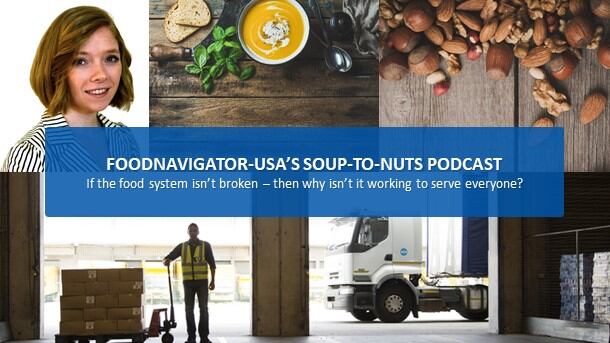Rather, the IDEO team argues, it is working exactly as designed – but the strain placed on it during the pandemic has exposed it for what it is: An outdated system “riddled with systemic inequalities that pit affordability against nourishment,” and which prizes the low-cost production of food at scale over nutrient density at expense of people’s health. And the fallout from this system, according to IDEO isn’t new either – it has been holding back generations of people from reaching their full potential.
Which is why the team at IDEO Design for Food studio are committed to rethinking the food system at every level – from the farm to the manufacturer to the consumer – so that people and the planet are at the center and they no longer need to choose between healthier options or convenience.
In this episode of FoodNavigator-USA’s Soup-to-Nuts podcast, IDEO Senior Design Director Rachel Maloney tackles big questions about how to reimagine a more functional and equitable food system and the role that different industry players have in improving the quality and health of food and the planet. She also explores how shifting the idea of so-called staple foods to more nutrient dense options and improving access to healthier food could impact the broader socio-economic landscape. Finally, she shares concrete advice about the best and the worst ways to help consumers improve their diets – all without getting lost in or overwhelmed by the overarching challenge ahead.
[Editor’s Note: Never miss another episode of FoodNavigator-USA’s Soup-To-Nuts podcast – subscribe today.]
The challenge ahead
Since the start of the pandemic when grocery store shelves were suddenly bare and farmers, ranchers and dairies were forced to destroy food and herds because they couldn’t process or ship them fast enough in the necessary form, stakeholders across the food industry alongside legislators, consumers and public health advocates have all called for collaborative new approaches to “fix the broken food system.”
But according to Maloney, more efficiently growing, manufacturing and delivering food that is better for people and the planet starts with the realization that the current food system isn’t actually broken. Once stakeholder realize this, Maloney says, they can brainstorm solutions for specific shortcomings of the current system, such as the negative impact of gradual consolidation of farms and manufacturers that concentrate decision-making power into the hands of a few who might not always prioritize the best interests of the masses.
“We did design this system, and we just happened to really design it for efficiency and scale, and so it is operating in the way we intended and as we designed,” but “as with a lot of highly efficient systems, when we designed it, we didn’t really leave a lot of room for error and we didn’t really design it for resiliency,” she explained.
By prioritizing efficiency to feed a growing population, the food system gravitated towards consolidation, which Maloney said led to only a few companies deciding what type of food to grow, produce and make available at retail and how to price it. Often the answers benefited business, but not consumers, she argued.
How do we design ourselves out of this situation – where do we start?
With a problem this complex, identifying a single starting point is impossible, and any attempts to do so likely would result in finger-pointing and misdirected blaming that could blind different players to their role in the current situation or delay their adoption of positive changes.
So, the first step in redesigning the food system is for everyone to recognize the roles and responsibilities of individual players within the bigger system, Maloney said.
For example, she explained for manufacturers working with farmers to source ingredients this means rethinking the impact of procurement on the nutritional value of finished products and the environment.
“Procurement contributes to a lot of the problems that we see in our food system, such as over production,” and reinforcement of intensive farming practices to meet demand while minimizing risk, such as that posed by growing new or diverse crops, Maloney said.
She said one way manufacturers can change this by working with farmers to create products that would support more diverse crop rotations. Think crackers made from the traditional cover crop lentils rather than just wheat.
Maloney also argues manufacturers need to take responsibility for emissions generated upstream to fill their orders. This may include working with farmers to adopt more environmentally friendly production practices, including sharing the risk or helping offset the costs associated with transitioning to alternative farming techniques that are better for the planet, or working with suppliers to reformulate products to use more upcycled ingredients.
Redefining ‘staple’ foods
Because manufacturers are literally stuck in the middle between producers and consumers, Maloney says they have an outsized role in redesigning the food system that requires them to work not just with farmers, but also shoppers to help them rethink and expand what they consider “staple” foods. She added, by broadening the definition of and access to healthy staples, manufacturers could also help make the new food system more equitable.
“A lot of our current recommendations for healthy eating doesn’t really represent culturally diverse food options,” which means some segments of the population don’t have access to foods they value or know how to prepare, or maybe only have access to foods they are not as familiar with, she explained.
To pull off offering – and profiting from – a more diverse selection of food, Maloney says, requires buy in beyond just food manufacturers and farmers to include retailers, influencers – such as celebrity chefs – and representatives from broader social structures to ensure previously overlooked consumers have the necessary resources to access nutritious foods that represent their cultures once they are produced in large quantities.
Consumers must play a role in redesigning the food system
While Maloney stresses that most of the heavy lifting in redesigning the food system will fall on industry players, including retailers, manufacturers and suppliers, but she said consumers also have a role to play in identifying what they need to be healthy and supporting those who provide it, rather than settling for the status quo or simply taking what is offered.
“Consumers do hold a certain level of power with obviously how they purchase, and there has been efforts, obviously, in labeling for nutritional content for growing practices,” but consumer education must be more widespread and easily understood, Maloney said.
She called out the Equitable Food Initiative as an emerging certification that helps consumers understand how a product supports workers, health and safety.
Collaboration is essential
If all of this sounds hard, that is because it is. And that is why Maloney stresses no one player can transform the food system alone – everyone has a role and responsibility and she says they all must work together.
“The call to action is ‘Don’t do this alone,’ right? When we’re thinking about tackling a challenge of this size, it has to take collaboration, and it is so interconnected that you have to consider a very diverse set of needs,” Maloney said. “And so I think we need to find ways to share both the risks and the rewards as we start to address this.”
She explained human centered design really allows stakeholders to consider the needs of all players and focus on how one aspect of a problem both impacts individuals and the larger system, and that is when solutions begin to emerge.
Even with teamwork, redesigning the food system is a daunting process, so to keep from becoming overwhelmed, Maloney concludes the most important step is just to start – somewhere, anywhere – and know that small changes will compound each other to eventually create a big change.




